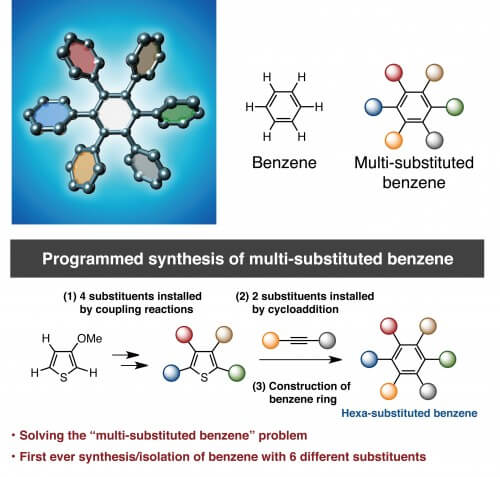Chemists from Nagoya University in Japan have developed an innovative synthetic method to achieve the first ever programmed synthesis of a polysubstituted benzene derivative with five/six different functional groups.

[Translation by Dr. Nachmani Moshe]
Chemists have succeeded in developing a new method for the programmed synthesis of bezanne derivatives with up to six different functional groups that allow access to innovative functional organic materials that could not be prepared before.
Chemists from Nagoya University in Japan have developed an innovative synthetic method to achieve the first ever programmed synthesis of a polysubstituted benzene derivative with five/six different functional groups. Benzene is one of the most common structures in the pharmaceutical world, with polysubstituted benzene derivatives also found in many organic electronic devices. Despite being extremely useful, multi-converted benzene derivatives are difficult to synthesize, due to the lack of selective methods for the introduction of different converters into a selected position.
The researchers were able to develop a unique continuous approach for the preparation of penta- and hexa-converted benzene derivatives. The study, published in the scientific journal Nature Chemistry, reveals the first-ever example of a controlled synthesis of benzene bearing six different chemical groups at all six positions, an example that illustrates the great potential of this method to prepare useful aromatics in a precisely programmed and predictable manner.
Benzene, first discovered in 1825, is a ring consisting of six carbon atoms with a single hydrogen atom attached to each of them. These six hydrogen atoms can be replaced by different converters, a fact that makes benzene an especially versatile building block in many materials, including in the fields of medicine, agriculture, plastics and electronic equipment. The number of possible derivatives of converted benzene can be huge - for example, for a system with 10 converters, the number of possible conversion patterns on benzene will be 86,185. Despite the fact that a large number of different converters can be connected to benzene, many of these systems have a symmetrical structure, which reduces the number of unique options. This is due to the fact that there is no effective general method for obtaining asymmetric multi-converted benzenes while fully controlling the location of the conversion. Although several articles have been published in the literature describing the selective conversion of up to 4 different aryl groups on a single benzene ring, the new method demonstrates for the first time ever the selective conversion of five and even six different aryl groups.
"We have been working on the development of programmed synthesis of multi-transformed aromatic systems for 15 years," says Kenichiro Itami, who is one of the leaders of the research. "Our ultimate goal is to solve the synthetic challenge of polysubstituted aromatic systems, a challenge that has been particularly complex due to the structural diversity of benzene and the limited number of synthetic methods." The key step in our method is the use of thiophene (a ring consisting of four carbon atoms and one sulfur atom) as our starting material," says the researcher. In 2009 we succeeded in developing the programmed synthesis of a thiophene ring to which we attached 4 different aryl groups with the help of the activation of the carbon-hydrogen chemical bond. In the next step, we improved this method and extended it to the preparation of polyconverted benzenes."
"On top of the converted thiophene we performed a series of coupling reactions with metal catalysis and then performed a cycloaddition for the preparation of a hexagonal ring." explains the researcher. "After countless attempts to find the appropriate reaction conditions, we were finally able to obtain the propeller-shaped crystal structure of the desired compound with six different conformers." The analysis of these novel asymmetric compounds revealed that the fluorescence ability of this compound can be tuned by changing the external modifiers. These results indicate the future applications that may grow from this innovative method while preparing new molecules that will be used in electronic components, nanotechnology and bio-imaging, among other possible fields.


One response
Is it possible to synthesize fuel from plastic waste, or create fuel in a complex process of melting sulfides with carbon?